Plunge into the memorable and endearing style of a city that invites you to explore its multicultural past and vigorous present. Here, at the foot of the Sierra Nevada mountains, you will be captivated by a majestic fortress palace which unveils a sublime tale of Moorish Spain. You will also roam the labyrinthine lanes of an Arab quarter, uncover a rich ancestry of culture and history and discover the ancient districts in a most appealing fashion. So, join us on this unforgettable journey through the best way to fully enjoy the city of Granada.
Immerse in the unique history of Alhambra
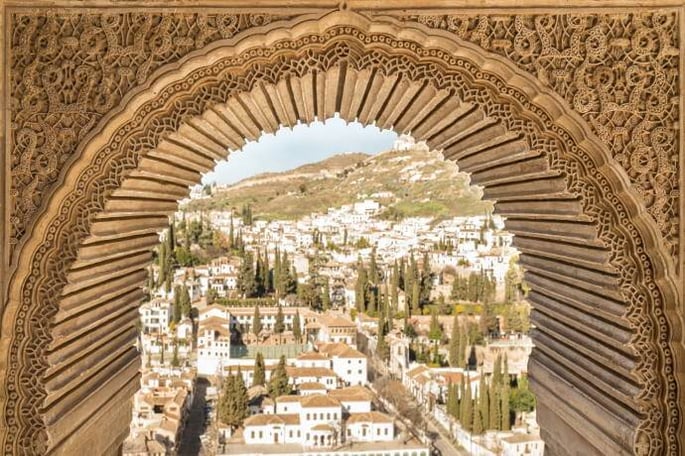
At the soul of the city, standing proud on the Darro River's hills, lies the majestic Alhambra, an important palace-cum-fortress that combines remarkable architecture with a riveting past. Built in the mid-13th century, Alhambra, or "The Red Fortress", has seen centuries of rulers, each of whom added their unique touch to this architectural wonder. Visiting the Alhambra means stepping into a time portal that catapults you back to an era of Moorish rule, romantic imagination and fascinating courtly lives.
The highlight of the Alhambra, the Nasrid Palaces, are a series of royal palaces built by the Nasrid dynasty. As you navigate through the labyrinth of luxurious rooms and courtyards, take a moment to marvel at the tangled Islamic geometric patterns adorning the walls, the delicate mosaics and the carvings whispering age-old Arabic poetry. Noteworthy is the Patio de los Leones, or Court of the Lions, named for its distinctive fountain, which is surrounded by 12 lion statues. This courtyard is a symbolic representation of paradise and a must-visit spot for any Alhambra visitor.
The Alcazaba is the military part of the Alhambra. Its robust watchtowers, such as the Torre de la Vela, offer a breath-taking panoramic angle of Granada, promising a perfect experience through the Nasrid Palaces. The raw and rugged beauty of the Alcazaba, contrasting with the opulence of the palaces, serves as a reminder of the fortress' primary defensive role. There is also the Palace of Charles V, an iconic Renaissance building within the Moorish citadel. Commissioned by the emperor Charles V after the Christian Reconquest, its circular courtyard and colossal structure are stark contrasts to the rest of the Alhambra. Housing two intriguing museums - the Museum of the Alhambra and the Fine Arts Museum – it is a place where you can lose yourself in a rich mixture of art and narrative.
Beyond the military stronghold and royal abodes, the Generalife - the sultans' summer palace - awaits. Known for its beautifully arranged fields, this fountain of stillness is the perfect place to unwind. As you stroll along the pathways, enjoy the soothing sounds of water trickling from fountains, the scent of blooming flowers and the pleasing views over Granada.
Alhambra has a unique appeal under the cloak of night. As the sun dips below the horizon, casting a warm glow over the red stones, the fortress lights up, promising a magical and unforgettable evening.
Every corner of this monumental complex tells a tale, paints a picture and sings a melody of its rich past.
Take a postcard picture at Mirador de San Nicolás
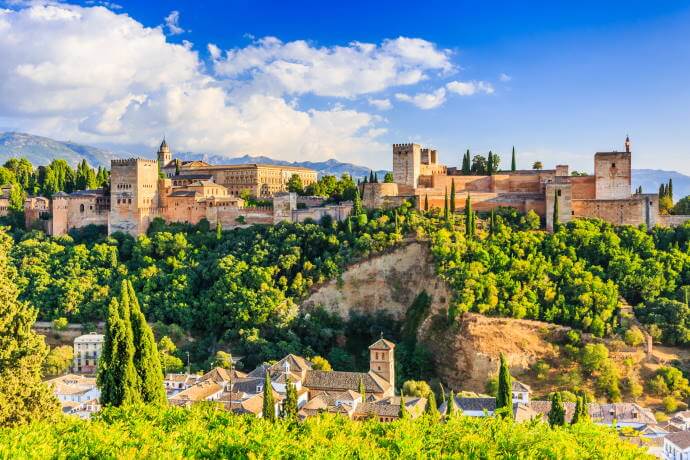
Situated in the charismatic Albaicín district, Mirador de San Nicolás has gained fame among travelers for its unmatched scenery of the Alhambra fortress. This lookout point is usually buzzing with tourists, photographers and sometimes even local musicians, adding an energetic soundtrack to the mesmerizing looks. Once you have found your perfect spot among the paved grounds, take a moment to soak in the sight. The Alhambra in the foreground, the Sierra Nevada mountains serving as a dramatic backdrop and the sprawling city of Granada at its feet – it is no wonder this scene has inspired countless artists and poets over the centuries. Make sure your camera or smartphone is ready to capture this truly postcard-worthy scenery.
For those seeking a more serene endurance away from the tourist burst of activities, we recommend the path less trodden - a climb up to the Mirador de San Miguel Alto. This route is less crowded but requires a bit more effort due to its steep nature. However, those willing to undertake this adventurous hike will be rewarded with an equally stunning, or better, unique perspective of Granada. The path winds through thin lanes, passing by whitewashed houses, lush gardens and hidden plazas. The ascent might be challenging, but the anticipation of what awaits at the top propels you forward.
Once at the Mirador de San Miguel Alto, catch your breath as you take in an awe-inspiring, almost 360-degree vision of Granada. From this vantage point, the Alhambra appears nestled in the core of the city, with the backdrop now including a vast expanse of Granada and its surrounding countryside. Both Mirador de San Nicolás and Mirador de San Miguel Alto offer lovely outlooks of the sunset. The sky dances in hues of orange, pink and purple, as the sun slowly dips behind the mountains. The Alhambra's red fortress walls start to glow, creating an ethereal landscape that leaves spectators and photographers alike spellbound.
Wander around in the Albaicín neighbourhood
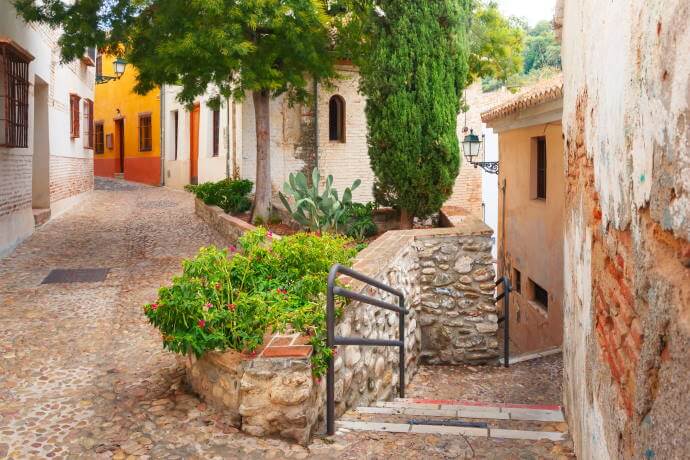
A trip to Granada is like phasing into a timeless painting, one where the brush strokes of days of old, culture and magic have created a mesmerizing tableau. One such piece in this vivid cityscape is the Albaicín neighbourhood, an ancient quarter that holds UNESCO World Heritage status.
From the moment you step into Albaicín, you are carried back to Granada's Moorish past. This neighbourhood is famous for its slender bending streets, reminiscent of a labyrinth, where every turn reveals a new revelation. Starting at the Plaza Larga, the active market square, you will encounter a riot of colour and a feast for the senses. Here it is possible to get some of the freshest local produce, explore small boutique shops, or simply enjoy a cup of Spanish coffee at a sidewalk café, watching the world go by.
As you stroll along Albaicín's streets, you will notice the distinctive Carmen houses, traditional Granada homes characterized by their walled greenhouses. The word 'Carmen' comes from the Arabic term for vineyard and these houses often hide lush, blooming gardens. Just a stone's throw away from Albaicín, you will find the Sacromonte neighbourhood. Known for its traditional cave houses and flamenco shows, Sacromonte provides a spirited contrast to Albaicín's snaking, tranquil streets. Visit one of the caves to witness an authentic Zambra performance, a form of flamenco native to Granada and immerse yourself in the fiery passion of Spanish dance.
Discover the Sacromonte houses

A place of folklore, flamenco and fascinating cave houses. Unfolded across the verdant Valparaiso Valley, Sacromonte is distinguished for its whitewashed cave buildings, known as 'cuevas'. But what makes these even more special is the unique community that has thrived here for centuries. The Sacromonte parish traces its origins back to the 15th century, when it was settled by Romani people following the Christian Reconquest of Granada. They carved homes into the hillsides, creating a complex network of caves, each bearing a unique memoir.
To truly understand the culture and antiquity of Sacromonte, a visit to the Cuevas del Sacromonte Museum is a must. Nestled among the hills, this museum is housed in a series of traditional caves, each displaying a different aspect of the Sacromonte lifestyle. As we walk through the museum, you will find yourself immersed in the region's past. Each cave has been carefully preserved and offers an intimate glimpse into the past - from the original interiors, to traditional tools and utensils, to displays showcasing the art of flamenco. These remnants of the past gracefully narrate the legacy of the neighbourhood's inhabitants, their culture and their deep-rooted traditions.
Sacromonte is the cradle of Zambra, a passionate form of flamenco that emerged from the Romani community's weddings and celebrations. The neighbourhood is dotted with 'tablao' flamenco venues, often situated within the cave houses themselves. A flamenco show in Sacromonte is an unforgettable event, filled with the raw emotion and fiery energy that this traditional dance invokes. As the sun dips below the horizon, the best place to be is in one of these flamenco caves, being swept away by the rhythm of the music and the heart-warming performances.
Marvel at the Royal Chapel
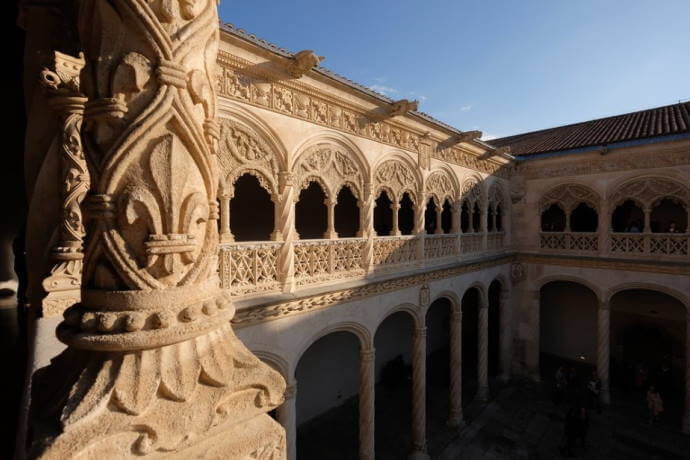
Settled amidst the lively streets of Granada, the Royal Chapel, or Capilla Real, is a majestic monument of significant ancient and architectural value. This hidden gem, known for its astonishing artwork, convoluted construction and rich history, offers an intimate glimpse into Spain's royal past.
The Royal Chapel holds a special place in the centre of Granada. Built between 1505 and 1517, it was ordered by the Catholic Monarchs, King Ferdinand II of Aragon and Queen Isabella I of Castile. Not only is it an architectural marvel, but it also serves as the final resting place of these illustrious monarchs, along with their daughter Joanna "the Mad" and her husband Philip "the Handsome". As we advance inside, prepare to be awestruck by the sheer magnificence of the chapel's interior. The centrepiece is the stunning marble tombs of the royal couples, hand-carved by Italian sculptor Domenico Fancelli. Lying in stark contrast to the white marble, the ornate golden altarpiece immediately catches the eye, marvelously illustrating scenes from the lives of the saints and the Passion of Christ.
Beneath the chapel, in the crypt, you can find the simple lead coffins where the remains of the monarchs are housed. This stark, solemn space offers a blessed contrast to the ornate beauty of the chapel above. Adjacent to the main chapel is the Sacristy-Museum, which has an incredible collection of artwork and personal items that belonged to the Catholic Monarchs. From Queen Isabella's personal art collection featuring works by Botticelli and Memling, to the crown and scepter used during the monarchs' funerals, each exhibit tells a fascinating tale about the Spanish royal past.
Every detail in the Royal Chapel has been crafted with a deep symbolic meaning. For instance, the chapel's layout represents the cross, a recurring theme in Christian architecture. The brilliant altarpiece is full of religious symbolism related to Christ's life and passion. Even the monarchs' tomb, with Ferdinand and Isabella holding hands, symbolizes their united rule. Exploring these details adds a layer of depth and intrigue to your visit.
Visit Granada Cathedral
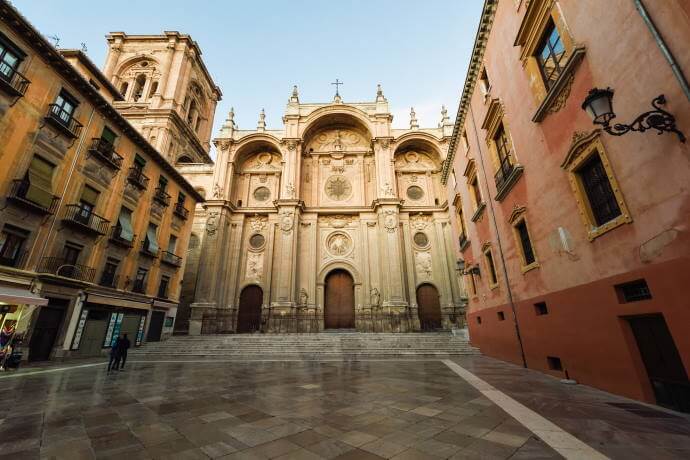
Also known as the Cathedral of the Incarnation, it is a stunning representation of Spanish Renaissance architecture. The foundation of the Granada Cathedral was laid on the site of the city's main mosque following the conquest of Granada by the Catholic Monarchs in 1492. Its construction spanned over 181 years, with the final touches applied in 1704. The long construction period led to a blend of architectural styles, but the cathedral is predominantly a masterpiece of the Spanish Renaissance style.
As we approach the cathedral, prepare to be amazed by its sheer size and the sophisticated façade. The cathedral boasts an impressive length of 115 meters and width of 67 meters, making it one of the largest cathedrals in Spain. The façade, a masterpiece by Alonso Cano, presents a harmonious combination of Renaissance and Baroque elements. Inside you are greeted by a spacious, brilliantly lit interior. The cathedral's layout is based on a five-nave plan rather than the typical three-nave motif seen in most Gothic cathedrals. The central nave draws your eyes upward to the stunning dome, surrounded by a symphony of columns and arches - a true testament to the grandeur of Renaissance architecture. The Capilla Mayor, or Main Chapel, houses the monumental Triumph of the Catholic Church over Paganism, an intricate piece by Francisco Mora. Numerous chapels line the sides of the cathedral, each possessing its own unique artistic treasures.
Perhaps the most poignant artwork in the cathedral is the series of twenty colossal paintings by Juan de Sevilla, displayed in the main sacristy. Depicting scenes from the life of Christ, these masterpieces showcase the pinnacle of Spanish Baroque painting. Adjacent to the cathedral stands the Royal Chapel, the final resting place of the Catholic Monarchs. While technically separate from the cathedral, the chapel's close proximity makes it an essential part of your visit, adding another layer to your chronicled journey.
Go shopping at the Alcaicería
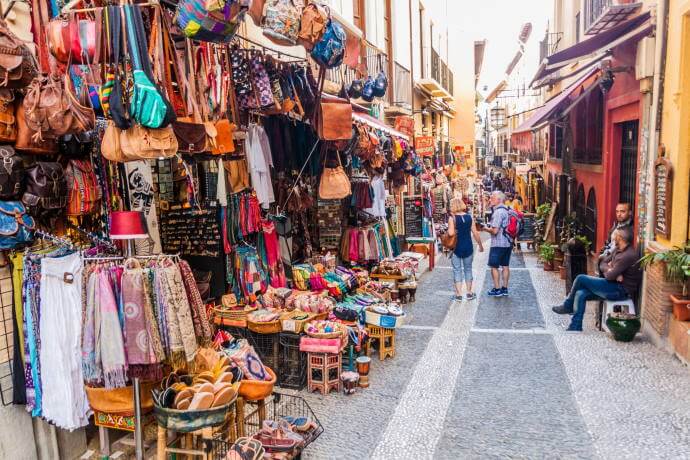
Also located in the middle of Granada, the Alcaicería Market was once a thriving Moorish silk market, where traders from across the Mediterranean would gather to barter and sell their goods. Although the original market was largely destroyed in a 19th-century fire, the rebuilt Alcaicería still retains the grace and bustle of its past, offering visitors a taste of Granada's rich historical facts.
As you delve through the narrow, meandering streets of the Alcaicería, get ready to be spanned away by a sensory overload. Vivacious hues of fabrics, the glitter of Moroccan lamps, the rich aroma of spices and the soft murmur of shopkeepers inviting passers-by to explore their wares - all these create an atmosphere of an exotic bazaar straight out of a storybook. The Alcaicería Market is a paradise for those seeking rare souvenirs and artisanal crafts. You can find traditional Andalusian ceramics with their tricky patterns, hand-woven carpets, delicately embroidered shawls and a stunning variety of silver jewellery. Granada is famous for its Taracea work - difficult woodwork inlaid with bone and mother-of-pearl - and you can find delicate examples of this technique in the Alcaicería as well!
Relax at Carmen de los Mártires Garden
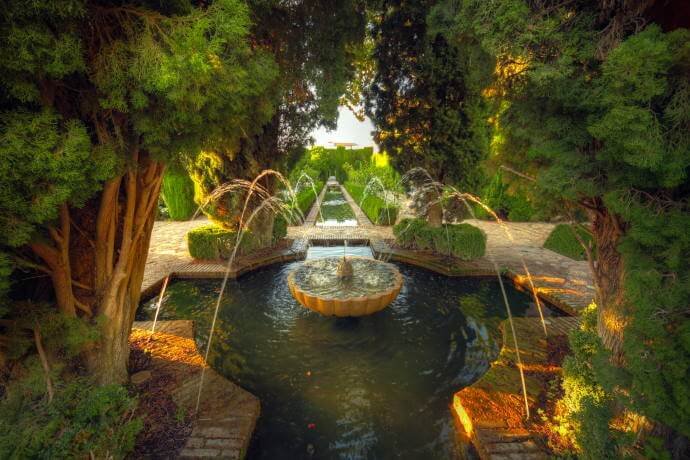
Originally part of a Nasrid palace, the Carmen de los Mártires Garden is situated next to the Alhambra and offers spectacular sights of the city and the surrounding Sierra Nevada mountains. Spread across seven hectares, the patio is a delightful blend of Spanish and English styles, adorned with picturesque fountains, glamourous statues and an intriguing duck pond.
Strolling through the lush greenery of the Carmen de los Mártires is like skipping into a fairy tale. Meandering paths lead you through meticulously manicured hedges, vivid flower beds and towering trees. Secluded benches are scattered throughout the back yard, offering ideal spots for a tranquil retreat. You will also encounter a series of mini-gardens, each offering its own distinct charisma, from the fragrant rose patios to the exotic Moorish Garden.
The highlight of the yard is the lookout tower, or Mirador. The short climb up the tower rewards you with scenic pictures of Granada, stretching from Albaicín to the stunning peaks of Sierra Nevada. The Mirador is also known as 'Torre de la Cautiva', or the Captive’s Tower, which is linked to a romantic legend. It is said that a Christian prince was imprisoned there and he fell in love with a Moorish princess who visited him secretly. Their tragic love myth adds a layer of mystique to this already winsome location.
Carmen de los Mártires is also a haven for various bird species. The serene duck pond is a favorite spot for visitors. Whether it is watching the playful antics of the ducks, or listening to the melodic chirping of the birds, the presence of wildlife enhances the coolness of this garden.
Go for Tea at Calle Elvira’s tea houses
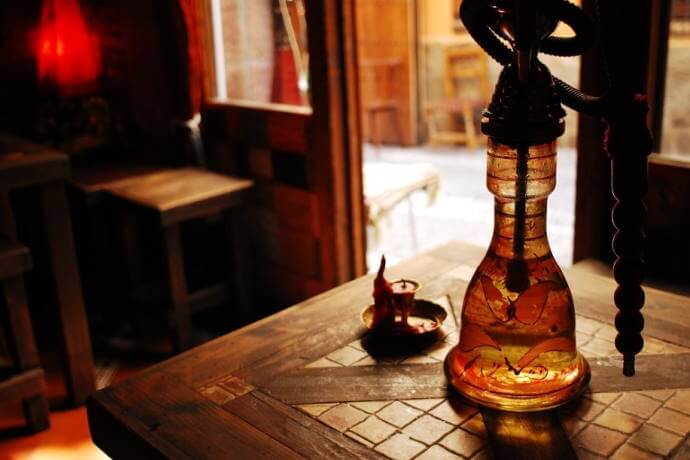
As the sun begins to set over the captivating city of Granada, it is time to wind down and feel one of the city's most relaxing traditions - a cup of aromatic tea at the alluring tea houses, or teterías, on Calle Elvira. Situated in the famous Albaicín district, Calle Elvira is a slim, twisty street brimming with Moorish lure. As you roam down this atmospheric lane, you are shifted back in time, immersed in the allure of Granada's Moorish past. Lined with whitewashed buildings adorned with wrought-iron balconies and blooming flower pots, Calle Elvira invites you to savour the slower pace of life. This street is filled with the famous teterías (tea houses) that are known for their seductive and oriental ambiance. With low-hanging lanterns casting a warm, welcoming glow, comfy floor cushions and the hypnotic tunes of Arabic music playing in the background, the teterías are an oasis of calmness.
The root of the teterías' appeal is, of course, their extensive menu of teas. From traditional Moroccan mint tea, served sweet and piping hot, to blends of black tea with rose petals, spices, or exotic fruits - the array of choices caters to every palate. Each pot of tea is meticulously brewed and elegantly served in traditional Moroccan teapots and colourful, hand-painted glasses. The act of sipping on these carefully crafted brews is not just a treat to the senses, but a ritual that transports you to the souks of Marrakesh.
To accompany your tea, these teterías offer a delightful selection of pastries and sweets. From the sticky sweetness of baklava, filled with honey and nuts, to the delectable Turkish pleasure, each treat is a sensory joy that perfectly complements the aromatic tea. As you sit in the ambient warmth of a Calle Elvira tetería, sipping on fragrant tea and nibbling on exotic pastries, Granada's rich blend of cultures truly comes to life. It is more than just a tea break – it is an invitation to slow down, to savour each moment and to immerse yourself in the sensory journey of Granada's cultural heritage.
As your journey in Granada concludes, you will leave with a heart filled with a vivid palette of enjoyments. The city's alluring blend of Moorish and Spanish cultures, captured in its mesmerizing architecture, vivid parishes and rich culinary scene, leaves an indelible imprint on every traveller. The appeal of Granada lies in its ability to time travel – from the whispers of the past in the Alhambra's fortified walls to the energetic flamenco beats echoing in Sacromonte's caves, the city is a living, breathing museum. Yet, it is more than its classical artifacts. Granada’s soul lies in the warmth of its people, the satisfaction of a traditional tapa with your drink and tranquil sunset hues over the Albaicín. Undoubtedly, Granada has a culture to be lived, a dance to be danced and a tale to be told.



